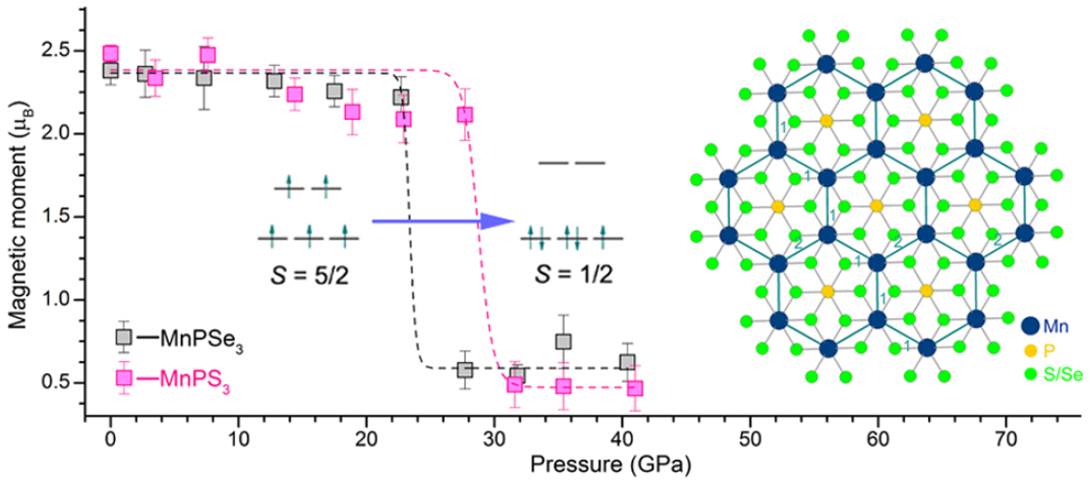Cooperative spin-crossover under pressure - Dr. Wenge Yang
DECEMBER 5, 2016
Spin crossover (SCO), an intriguing phenomenon that magnetic ions can switch between high-spin (HS) and low-spin (LS) states in response to light irradiation or temperature, is mostly observed as a spectacular molecular magnetism in 3d4-3d7 metal complexes. In particular, SCO materials can be multifunctional when a light- or temperature-induced SCO occurs along with structural and/or electrical alterations, and thus hold great promise for applications such as memory, display and sensor. Contrastively, pressure-induced SCO often occurs as a progressive process due to the gradual effect of pressure on the inter-atomic distance and bandgap. This greatly hinders harnessing pressure-induced SCO for potential applications in sensors or memory devices. A joint team of researchers from UNLV, HPSynC and HPSTAR reported their breakthrough in pursuing "cooperative" pressure-driven SCO in J. Am. Chem. Soc. (DOI: 10.1021/jacs.6b10225). An abrupt pressure-driven SCO accompanying with large lattice collapses and semiconductor-to-metal transitions was achieved in two-dimensional honeycomb lattices, MnPS3 and MnPSe3, for the first time. The work opens a new avenue for the exploration of pressure-responsive multifunctional materials.
According to the crystal-field theory, whether or not a transition metal ion embedded in the crystalline matrix will have a HS or LS electron configuration is determined by the magnitude of the crystal-field splitting energy (∆=10Dq) along with the Hund's intra-atomic exchange energy (J). Pressure, as an alternative external stimulus to light or thermal excitation, is an efficient tool for altering crystal field strength by shortening the metal-ligand bond-lengths, and thus has promise to drive SCO in strongly correlated systems. Previous researches on representatives including FeS, (Mg,Fe)O and (Mg,Fe)(Si,Al)O3 have provided in-depth understanding of the concurrent structural and electronic anomalies, and seismic-wave heterogeneity in the Earth's lower mantle.
“However, when revisit from the viewpoint of material science, one of the most challenge question is, can we make pressure-induced SCO potential as practical switching materials, just as those of light- or temperature-induced SCO materials?”, said a co-lead author on the research, Wenge Yang, also a staff scientist of HPSTAR. "To approach this goal, the pressure-driven SCO process should be sharp rather than gradual or progressive".
 This work is a continue of their previous work on MnS and MnSe (Angew. Chem. Int. Ed., 2016, 55, 10350), where they predicted that the pressure-induced SCO should be a universal behavior in manganese chalcogenides. Now they switch to two-dimensional honeycomb compounds MnPS3 and MnPSe3. X-ray emission spectra shows an abrupt SCO (from HS (S=5/2) to LS (S=1/2)) in both materials around 25−30 GPa. Their following in-situ high-pressure structural and transport characterizations show that the sharp pressure-driven SCO accompanies large in-plane lattice collapse and a semiconductor-to-metal transition, indicating a strongly cooperative mechanism that facilitates the occurrence of the abrupt pressure-driven SCO.
This work is a continue of their previous work on MnS and MnSe (Angew. Chem. Int. Ed., 2016, 55, 10350), where they predicted that the pressure-induced SCO should be a universal behavior in manganese chalcogenides. Now they switch to two-dimensional honeycomb compounds MnPS3 and MnPSe3. X-ray emission spectra shows an abrupt SCO (from HS (S=5/2) to LS (S=1/2)) in both materials around 25−30 GPa. Their following in-situ high-pressure structural and transport characterizations show that the sharp pressure-driven SCO accompanies large in-plane lattice collapse and a semiconductor-to-metal transition, indicating a strongly cooperative mechanism that facilitates the occurrence of the abrupt pressure-driven SCO.
“From three-dimensional to two-dimensional, from Geosciences to Material Chemistry, I got this inspiration from the light- or temperature-induced SCO in ambient metal-organic complexes, where an abrupt spin change indicates a remarkable "cooperative behavior" between neighboring metal centers.”, said by the project leader Dr. Wang from UNLV and HPSynC. “MnPS3 and MnPSe3 are ideal low-dimensional confined systems, better than those mineral candidates to realize cooperative pressure-driven SCO. The magnetic spins located on the confined Mn honeycomb lattice are expected to accommodate neighboring spins more collectively than in other 3D crystalline materials”.
"Although the cooperative pressure-driven SCO is already a big-step ahead towards the rational design of multifunctional pressure-responsive materials, there is still a long way to go." said Yonggang. "What should a pressure-driven SCO be in a one-dimensional system? Is it possible to realize a metal-to-insulator transition through pressure-driven SCO, just as what happens in transparent sodium under ultra high pressure?"
Caption: IAD and spin values as a function of pressure, obtained relative to the ambient spectra of MnPS3 and MnPSe3; Proposed high-pressure structure for MnPS3 and MnPSe3
处于晶体场中的第一过渡族金属离子(d4-d7)可以有高自旋基态或低自旋基态。当两者能量相近时,在诸如温度、光照等外界激励下材料可能发生高低自旋态的互变,此现象称为自旋交叉(spin crossover)。自旋交叉化合物具有理想的双稳态,可以用于光、热开光或信息存储器件。然而对比于常压下光/热激励的自旋交叉配合物材料,压致自旋交叉常常表现出渐变效应(非突变型),该类材料目前也仅局限于与地学相关的研究。北京高压科学研究中心的杨文革研究员参与的一个研究小组一直致力于压致自旋交叉新材料的研究。他们首先预言了压致自旋交叉现象在铁锰硫族化合物中是普遍存在的,然后通过降低材料的维度(3D到2D)的方法提高金属离子间的协同效应,在层状蜂窝反铁磁体MnPS3和MnPSe3中实现了"协同压致自旋交叉"。随压力的升高,在上述材料中观测到了陡峭的高低自旋变化,而且伴随着面内晶格坍塌和金属化现象。他们希望该研究结果能够一方面为进一步的理论研究提供模型体系,另一方面为探索更多的压力响应的新材料和相关开关器件研究提供参考。
